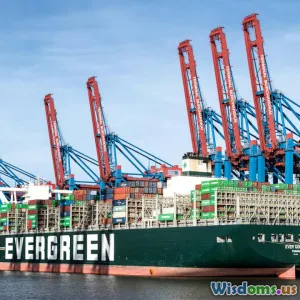
Tracing Globalization Through the History of Shipping Containers
7 min read Explore how shipping containers revolutionized global trade and shaped modern globalization through innovation, challenges, and economic impact. (0 Reviews)
Tracing Globalization Through the History of Shipping Containers
Introduction
Globalization is often described through images of sprawling networks, bustling multinational corporations, or digital data streams crossing continents. Yet, behind the scenes lies a silent revolution in our physical world—one that forever changed how products, people, and cultures interconnect. The unassuming shipping container is at the heart of this revolution. This steel box, designed to fit seamlessly onto ships, trains, and trucks, not only standardized freight but also accelerated globalization in a way few inventions have.
From its surprising inventor to reshaping global supply chains, the shipping container offers a unique window to trace the evolution of globalization itself. This article dives deep into the history of the shipping container, illustrating how a simple innovation became a cornerstone of international trade, altered economic landscapes, and linked the world more tightly than ever before.
The Dawn of Containerization: From Idea to Industry
Malcom McLean and the Container Concept
The birthplace of containerization is courtesy of Malcom McLean, an American trucking entrepreneur frustrated by the inefficiencies of traditional break-bulk shipping. In the 1950s, loading and unloading ships were labor-intensive and time-consuming, costing precious days at ports worldwide.
McLean’s insight came from envisioning a reusable, standardized container that could be quickly transferred between trucks, ships, and trains without unpacking individual goods. By 1956, his converted tanker ship, the Ideal X, sailed with the world’s first container cargo—58 metal containers from Newark to Houston. This journey marked a turning point in logistics.
Early Challenges and Industry Resistance
Despite McLean’s vision, the shipping and port industries resisted containerization initially. Stevedores feared job losses, and investments required to retrofit ports were considerable. Moreover, the lack of universally agreed container standards hindered widespread adoption.
However, in 1961, McLean and other industry stakeholders collaborated to form the International Organization for Standardization (ISO), defining container dimensions, locking mechanisms, and stacking rules. These standards were crucial for creating interoperability—containers from one line fit every global platform.
Containerization as a Catalyst for Globalization
Revolutionizing Trade Efficiency and Cost Reduction
By the 1970s, container ships replaced older cargo vessels en masse. Economies of scale skyrocketed; the cost to ship a ton of goods dropped from upwards of $5 to below $0.15 in today’s value. Shipping times shortened substantially, moving goods faster and making supply chains more reliable.
A 2018 Harvard Business Review study highlighted that containerization was responsible for nearly a third of the decline in average freight costs globally throughout the late 20th century. This dramatic cost reduction empowered companies to globalize operations, sourcing materials and labor for price optimization.
Effects on Global Supply Chains
The container turned the globe into a vast factory floor, where raw materials, components, and finished products moved fluidly across national boundaries. Companies transformed supply chains from linear processes within borders to intricate global networks.
Take the example of the smartphone industry: components manufactured across Asia, Europe, and America arrive by container to assembly plants in countries like China before being shipped worldwide. This assembly-line globalization would have been impossible without efficient container logistics.
Development of Mega Ports & Infrastructure
Ports evolved to accommodate container volumes: Rotterdam, Shanghai, and Los Angeles became major container hubs with automated cranes and storage yards. The scale is staggering—Shanghai’s Yangshan Deep-Water Port managed approximately 47 million TEUs (Twenty-foot Equivalent Units) in 2023 alone, dwarfing traditional ports.
Governments coordinated investments in railroads, highways, and inland container depots, creating multimodal transport systems. This infrastructure fabric woven by container requirements tightly integrated regions into global commerce arteries.
Social and Economic Impact
Global Job Market Realignments
While containerization eliminated some traditional dockworker jobs due to mechanization, it simultaneously created new employment avenues in logistics, manufacturing, port management, and technology.
Studies from the International Labour Organization (ILO) show mixed effects: in developed countries, cargo handling jobs declined, but in emerging economies, increased export volumes spurred manufacturing employment.
Facilitating the Rise of Consumer Culture
Mass-produced goods such as clothing, electronics, and furniture became cheaper and more accessible thanks to container-fueled trade expansion. This accessibility helped birth a worldwide consumer culture characterized by abundance and variety.
Environmental Considerations
Container shipping contributed to globalization's environmental footprint. While ship transport remains more energy-efficient per ton-kilometer than air or road, the sheer volume of goods moved globally amplifies environmental impacts like greenhouse gas emissions. Modern ports and shipping companies increasingly explore sustainable practices, such as cleaner fuels and electric equipment.
The Future of Shipping Containers in a Changing Global Landscape
Innovations in Container Technology
Smart containers embedded with IoT sensors now enable real-time tracking of goods’ condition and location, enhancing supply chain transparency and efficiency. Innovations in materials reduce container weight, improving vessel fuel efficiency.
Challenges from Geopolitical Shifts and Supply Chain Risks
Recent trade tensions, such as US-China tariffs, and COVID-19 disruptions have revealed vulnerabilities in highly globalized container networks. Companies are reconsidering the resilience of
Rate the Post
User Reviews
Popular Posts



















